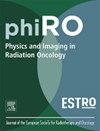Effect of end expiration breath hold on target volumes and organ at risk doses for oesophageal cancer radiotherapy
IF 3.4
Q2 ONCOLOGY
引用次数: 0
Abstract
Background and Purpose
The end expiration breath hold (EEBH) technique has the potential to reduce tumour motion during radiotherapy treatment of lower oesophageal cancer, and therefore, motion artefacts, target volumes and dose to surrounding organs at risk (OAR). EEBH is an emerging technique and clinical data on its use in oesophageal cancer is scarce.
Methods and Materials
A comparison of 20 lower oesophageal cancer patients was performed for radiotherapy treatment plans in both EEBH and free breathing (FB). EEBH and FB plans were evaluated and compared in terms of motion artefacts, target volumes and dose-volume metrics.
Results
EEBH was effective in reducing the observed motion artefacts seen in planning CTs compared to FB. EEBH also significantly reduced the average PTV size between EEBH and FB (ΔV = -48 ± 55 cm3; p < 0.001). OAR-PTV overlap volumes were also effectively reduced in EEBH compared to FB, including for lung-PTV overlaps (ΔV = -13 ± 13 cm3; p < 0.001) and for heart-PTV overlaps (ΔV = -8 ± 14 cm3; p = 0.02). Mean heart doses were lower on average by −1.2 ± 2.0 Gy with EEBH (p = 0.02), and mean lung doses by −1.0 ± 1.0 Gy (p < 0.001). Mean liver doses were on average reduced with EEBH by −0.6 ± 1.5 Gy, whereas spinal D2cm3 increased in EEBH compared to FB by 1.8 ± 6.3 Gy, but neither were statistically significant.
Conclusion
Use of EEBH for oesophageal cancer radiotherapy reduced motion artefacts and increased confidence in contouring volumes. Additionally, planning target volumes and doses to key OARs were reduced with EEBH compared to FB plans.
末呼气屏气对食管癌放射治疗靶体积和危险器官剂量的影响
背景与目的末呼气屏气(EEBH)技术有可能减少下食管癌放疗过程中肿瘤的运动,从而减少运动假影、靶体积和周围危险器官(OAR)的剂量。EEBH是一项新兴技术,其在食管癌中的临床应用资料很少。方法与材料对20例下食管癌患者进行EEBH和自由呼吸(FB)两种放射治疗方案的比较。根据运动伪影、靶体积和剂量-体积指标对EEBH和FB方案进行评估和比较。结果与FB相比,seebh可以有效地减少在计划ct中观察到的运动伪影。EEBH还显著降低了EEBH和FB之间的平均PTV尺寸(ΔV = -48±55 cm3;p & lt;0.001)。与FB相比,EEBH的桨叶- ptv重叠体积也有效减少,包括肺- ptv重叠(ΔV = -13±13 cm3;p & lt;0.001),心脏- ptv重叠(ΔV = -8±14 cm3;p = 0.02)。EEBH组心脏平均剂量降低- 1.2±2.0 Gy (p = 0.02),肺平均剂量降低- 1.0±1.0 Gy (p <;0.001)。平均肝脏剂量与EEBH相比平均减少- 0.6±1.5 Gy,而脊柱D2cm3与FB相比增加1.8±6.3 Gy,但两者均无统计学意义。结论:在食管癌放疗中使用EEBH可减少运动伪影,提高对轮廓体积的信心。此外,与FB计划相比,EEBH计划减少了关键桨的目标体积和剂量。
本文章由计算机程序翻译,如有差异,请以英文原文为准。
求助全文
约1分钟内获得全文
求助全文
来源期刊

Physics and Imaging in Radiation Oncology
Physics and Astronomy-Radiation
CiteScore
5.30
自引率
18.90%
发文量
93
审稿时长
6 weeks
 求助内容:
求助内容: 应助结果提醒方式:
应助结果提醒方式:


